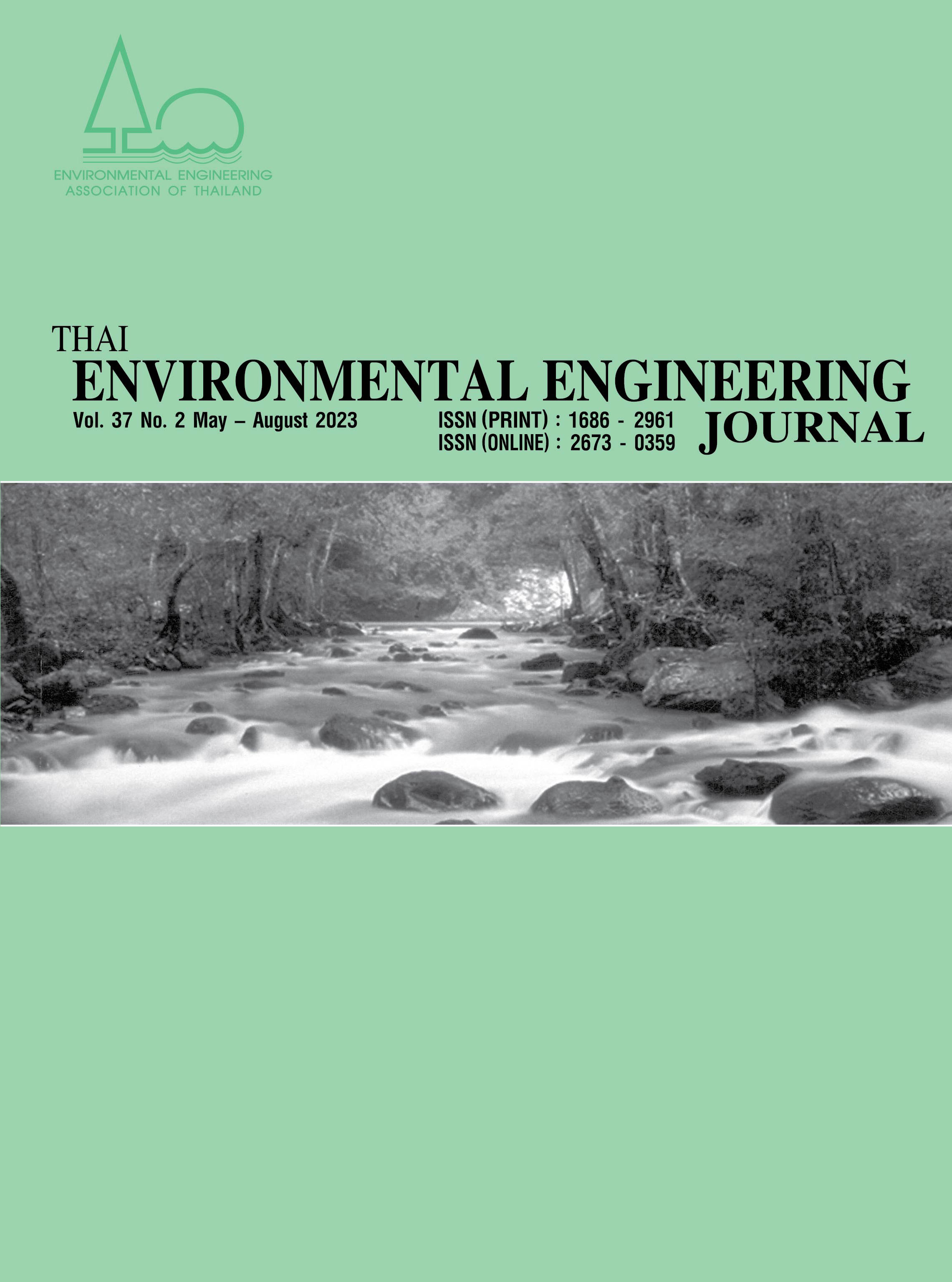The Water Footprint of Pa La-U Durian
Main Article Content
Abstract
The study’s objectives of this research were to assess the water footprint of Pa La-U Durian in Huai Sat Yai, Hua Hin, Prachuap Khiri Khan Province. By collecting primary data from interviews with farmers and related secondary data which were calculated by CROPWAT 8.0 program, the water footprint of Pa La-U Durian had an average of 2,284.67 m3/rai (2.79 m3/kg), divided into the amount of rainwater used (Green water), which was equal to 1,008.46 m3/rai (1.23 m3/kg), irrigation water consumption (Blue water), which was equal to 692.36 m3/rai (0.85 m3/kg), and the amount of water used in pollution treatment (Grey water) which was equal to 583.91 m3/rai (0.71 m3/kg). According to the study’s findings, which took into account each growth period, the branch growing period has the highest water footprint, measuring 745.39 m3/rai (0.91 m3/kg), because it contains the most green water and grey water in comparison to other growth periods. Grey water should be reduced, and farmers should be encouraged to use organic fertilizers, bio fertilizers, or microorganisms, as part of a strategy to reduce the water footprint of the production process. Due to the proportion of nitrogen in fertilizer in organic fertilizers being less than chemical fertilizers and leaching-runoff of organic fertilizers equal to 0.06 [1], while chemical fertilizers equal to 0.1 [2], resulting in a decrease in the grey water footprint from 583.91 m3/rai (0.71 m3/kg) to 24.81 m3/rai (0.03 m3/kg). As a result, the water footprint will be reduced to 1,725.59 m3/rai (2.11 m3/kg), which will not only lessen its negative effects on the environment but also encourage the growth of sustainable agriculture. In addition, the results of this research can be used for the monthly water footprint to plan the allocation of irrigation water to support the needs of Pala-U durian in each growth period.
Article Details
References
IPCC. 2019. IPCC Guidelines for National Greenhouse Gas Inventories: Emissions from livestock and manure management. Retrieved from https://www.ipccnggip.iges.or.jp/public/2019rf/pdf/4_Volume4/19R_V4_Ch10_Livestock.pdf.
Hoekstra AY, Chapagain AK., Mekonnen MM, Aldaya MM. 2009. Water footprint manual: State of the Art 2009. Retrieved from https://ris.utwente.nl/ws/portalfiles/portal/5146564/Hoekstra09WaterFootprintManual.pdf.
Trade Policy and Strategy Office. 2020. Durian is King of Fruit in Thailand. Retrieved from http://www.tpso.moc.go.th/sites/default/files/thueriiyn_240863.pdf.
Department of Intellectual Property. 2019. GI Thailand. Bangkok: Onpa Company Ltd.
Prachuap Khiri Khan Provincial Agriculture and Cooperatives Office. 2022. Summary of the Prachuap Khiri Khan provincial monthly agricultural production calendar for the year 2021. Retrieved from https://www.opsmoac.go.th.
Royal Irrigation Department. 2022. EIA Monitoring Report: Ban Pa La-U Reservoir. Bangkok: Bureau of Project Management.
Direk Tongara et al. 2002. Plant Watering Design and Technology (Revised Edition). 2nd Publication. Bangkok: Than Printing.
Hoekstra, AY., Chapagain, AK., Mekonnen, MM. and Aldaya MM. 2011. The water footprint assessment manual: Setting the global standard. Cornwall: TJ International Ltd.
Office of the National Environment Board. 1994. Surface water quality standard. Retrieved from https://www.pcd.go.th/laws/4168.
Royal Irrigation Department. 2017. Environmental Impact Assessment Report: Ban Pa La-U Reservoir. Retrieved from https://eia.onep.go.th.
Land Development Department. 2007. Improving soil to increase durian yield. Retrieved from http://www1.ldd.go.th/menu_Dataonline/G2/G2_11.pdf.
Marianne Bechmann., Inga Greipsland., Hugh Riley. and Hans Olav Eggestad. 2012. Nitrogen losses from agricultural areas-a fraction of applied fertilizer and manure. Bioforsk, 7: 8-9.
Sumit Kunjet. 2018. Study of water demand and appropriate watering method for Mon Thong durian. Chantaburi: Burapha University.
TGO Climate Action Academy. 2010. Economics of Climate Change. Retrieved from https://caacademy.tgo.or.th.
Stephan, P., Annette, K. and Stefanie, H. 2009. Assessing the Environmental Impacts of Freshwater Consumption in LCA. Environmental Science & Technology, 43: 4098-4104.
Gheewala, SH., Silalertruksa, T., Nilsalab, P., Mungkung, R., Perret, SR. and Chaiyawannakarn, N. 2014. Water footprint and impact of water consumption for food, feed, fuel crops production in Thailand. MDPI, 6: 1698-1718.
Office of the National Water Resources. 2020. SEA report of Phetchaburi-Prachuap Khiri Khan River Basin Area. Retrieved from https://sea.nesdc.go.th/report21/.
Cheng Liu, Carolien Kroeze, Arjen Y. Hoekstra and Winnie Gerbens-Leenes. 2012. Past and future trends in grey water footprints of anthropogenic nitrogen and phosphorus inputs to major world rivers. Ecological Indicators, 18: 42-49.
Jirayut Kotcharit et al. 2019. Evaluation of fresh Monthong durian water footprint in large-scales agricultural project area case study: Khlong Pun Subdistrict, Klaeng District, Rayong Province and Song Phi Nong Subdistrict, Tha Mai District, Chanthaburi Province. Retrieved from https://eng.kps.ku.ac.th/irre/project/pdf/256209.pdf.
Suphawadee Jampala et al. 2021. Water Footprint Assessment of Durian Monthong Before Harvesting and the Harvesting Period in Rayong Province. The 4th Environment and Natural Resource International Conference (ENRIC 2021) (pp.88-96).
Regional Office of Agricultural Economics 6. 2015. Study on Water Footprint of Durian in the “Large Plot Farming Project”. Retrieved from http://oaezone.oae.go.th/view/15/test/TH-TH.
Land Development Department. 2023. Soil group. Retrieved from http://dinonline.ldd.go.th/SoilMap.
Office of Agricultural Economics. 2020. Agricultural production data. Retrieved from https://www.oae.go.th.
Preecha Kapetch et al. 2020. Sugarcane Water Footprint under Rainfed and Irrigation Conditions of Some Major Production Areas. Thai Agricultural Research Journal, 39: 17-28.
Walaiporn Sasiprapa et al. 2022. Assessment of Cassava Water Footprint in Farmers’ Fields. Thai Agricultural Research Journal, 40: 265-275.
Woranee Pangjuntuek and Jitti Mungklasiri. 2013. Comparative study on the water footprint of oil palm in Pathumthani and Chonburi provinces. Research and Development Journal, 25: 113-120.
Onkawi Srithong. 2018. A Study of Water Footprint of Rice in Supanburi Province. Journal of Engineering, RMUTT: 24-32.
Thongchai Srinoppakun. 2013. Water footprint of palm oil product, biodiesel and rubber. Pathumthani. Ministry of Science and Technology.


